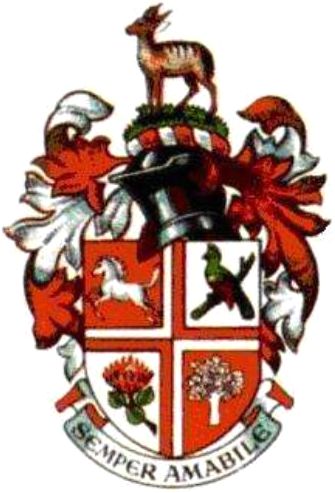George: Difference between revisions
Knorrepoes (talk | contribs) m (Text replacement - "====Origin/meaning====" to "===Origin/meaning===") |
Knorrepoes (talk | contribs) No edit summary |
||
| Line 6: | Line 6: | ||
District Municipality : Eden | District Municipality : Eden | ||
[[File: | [[File:george1.jpg|center|Arms (crest) of {{PAGENAME}}]] | ||
===Official blazon=== | ===Official blazon=== | ||
*(af) | |||
'''Wapen''': Gevierendeel van rooi en silwer, 'n kruis, kruislings verdeel van die een in die ander, in die eerste kwartier vergesel van 'n silwer hardlopende perd, in die tweede kwartier van 'n Knysnaloerie sittend op 'n skuinslinksgeplaaste tak, in die erde kwartier van 'n gestingelde en geblaarde proteablom, alles van natuurlike kleur, en in die vierde kwartier van 'n silwer bevrugte eikeboom, die stam afgesnede.<br> | |||
'''Helmteken''': 'n Bosbok van natuurlike kleur staande op 'n groen uitkomende rysende grond.<br> | |||
'''Wrong en Dekklede''': Rooi en silwer.<br> | |||
'''Wapenspreuk''': SEMPER AMABILE | |||
*(en) | |||
'''Arms''': Quarterly, Gules and Argent, a cross per cross counterchanged, between in the first quarter a horse courant of the second, in the second quarter a Knysna loerie perched upon a branch in bend sinister, in the third quarter a protea flower slipped and leaved, proper, and in the fourth quarter an oak tree fructed, the trunk couped, Argent.<br> | |||
'''Crest''': A bushbuck proper statant upon a mount issuant Vert.<br> | |||
'''Wreath and mantling''': Gules and Argent.<br> | |||
'''Motto''': SEMPER AMABILE | |||
===Origin/meaning=== | ===Origin/meaning=== | ||
The | The arms were officially granted in 1958 by the College of Arms in London and on June 14, 1994 by the South African Bureau of Heraldry. | ||
The town was named after King George III of the UK. The town first used arms at the beginning of the 20th century, which were never granted: | |||
[[File:george.jpg|center|Arms (crest) of {{PAGENAME}}]] | |||
The | The red cross is the cross of St George (patron saint of England), and bird in the second quarter is a Knynsa loerie, which is indigenous to the area. | ||
the second quarter a | |||
The first quarter presumably comes from the Hanoverian | In 1958 the arms were officially granted. The new first quarter presumably comes from the Hanoverian coat of arms, which formed part of the British royal arms until 1837. The loerie and the oak tree were retained in the second and fourth quarters respectively, and the flowers in the third quarter were replaced with a protea, which is the national flower emblem. | ||
coat of arms, which formed part of the British royal | |||
arms until 1837. The loerie and the oak tree were | |||
retained in the second and fourth quarters | |||
respectively, and the flowers in the third quarter | |||
were replaced with a protea, which is the national | |||
flower emblem. | |||
{{media}} | {{media}} | ||
| Line 41: | Line 36: | ||
[[Category:South African Municipalities]] | [[Category:South African Municipalities]] | ||
[[Category:Eastern Cape]] | [[Category:Eastern Cape]] | ||
[[Category:Granted 1958]] | |||
[[Category:Granted 1994]] | |||
Revision as of 06:16, 12 April 2020
| Heraldry of the World |
| South Africa heraldry portal Civic heraldry of South Africa |
|
GEORGE
Province: Western Cape (until 1994 Cape Province)
District Municipality : Eden
Official blazon
- (af)
Wapen: Gevierendeel van rooi en silwer, 'n kruis, kruislings verdeel van die een in die ander, in die eerste kwartier vergesel van 'n silwer hardlopende perd, in die tweede kwartier van 'n Knysnaloerie sittend op 'n skuinslinksgeplaaste tak, in die erde kwartier van 'n gestingelde en geblaarde proteablom, alles van natuurlike kleur, en in die vierde kwartier van 'n silwer bevrugte eikeboom, die stam afgesnede.
Helmteken: 'n Bosbok van natuurlike kleur staande op 'n groen uitkomende rysende grond.
Wrong en Dekklede: Rooi en silwer.
Wapenspreuk: SEMPER AMABILE
- (en)
Arms: Quarterly, Gules and Argent, a cross per cross counterchanged, between in the first quarter a horse courant of the second, in the second quarter a Knysna loerie perched upon a branch in bend sinister, in the third quarter a protea flower slipped and leaved, proper, and in the fourth quarter an oak tree fructed, the trunk couped, Argent.
Crest: A bushbuck proper statant upon a mount issuant Vert.
Wreath and mantling: Gules and Argent.
Motto: SEMPER AMABILE
Origin/meaning
The arms were officially granted in 1958 by the College of Arms in London and on June 14, 1994 by the South African Bureau of Heraldry.
The town was named after King George III of the UK. The town first used arms at the beginning of the 20th century, which were never granted:
The red cross is the cross of St George (patron saint of England), and bird in the second quarter is a Knynsa loerie, which is indigenous to the area.
In 1958 the arms were officially granted. The new first quarter presumably comes from the Hanoverian coat of arms, which formed part of the British royal arms until 1837. The loerie and the oak tree were retained in the second and fourth quarters respectively, and the flowers in the third quarter were replaced with a protea, which is the national flower emblem.
Contact and Support
Partners:
Your logo here ?
Contact us
© since 1995, Heraldry of the World, Ralf Hartemink 
Index of the site
Literature : Image scanned from a cigarette card from the 1930s













